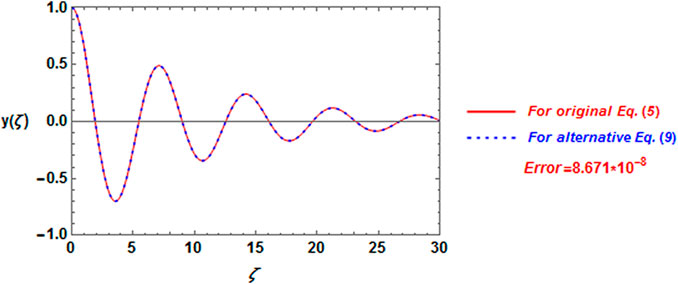- 1Department of Mathematics, Faculty of Education, Ain Shams University, Cairo, Egypt
- 2Department of Physics, College of Science, Princess Nourah bint Abdulrahman University, Riyadh, Saudi Arabia
The present work attracts attention to obtaining a new result of the periodic solution of a damped nonlinear Duffing oscillator and a damped Klein–Gordon equation. It is known that the frequency response equation in the Duffing equation can be derived from the homotopy analysis method only in the absence of the damping force. We suggest a suitable new scheme successfully to produce a periodic solution without losing the damping coefficient. The novel strategy is centered on establishing an alternate equation apart from any difficulty in handling the influence of the linear damped term. This alternative equation was obtained with the rank upgrading technique. The periodic solution of the problem is presented using the non-perturbative method and validated by the modified homotopy perturbation technique. This technique is successful in obtaining new results toward a periodic solution, frequency equation, and the corresponding stability conditions. This methodology yields a more effective outcome of the damped nonlinear oscillators. With the help of this procedure, one can analyze many problems in the domain of physical engineering that involve oscillators and a linear damping influence. Moreover, this method can help all interested plasma authors for modeling different nonlinear acoustic oscillations in plasma.
1 Introduction
In the range of differential equations, various physical manifestations, such as acoustic waves in plasma physics, and many engineering problems are modeled. A lot of scientists have made magnificent efforts to evaluate the solution of these differential equations. Different techniques have been utilized to evaluate the corresponding solutions. Modeling different biological, physical, and biochemical engineering problem occurrences, in general, yields nonlinear partial differential equations (PDEs). Moreover, plasma physics is one of the most fertile fields for many researchers interested in studying nonlinear phenomena. To perform modeling, the nonlinear phenomena that propagate in different plasma systems and many ordinary and partial differential equations must be solved. For this purpose, different mathematical approaches have been introduced for modeling several physical problems. Recently, a damped nonlinear oscillator model has been widely considered in practical engineering, general physics, and in plasma physics. For mathematical scientists, an article on nonlinear PDEs, which are addressed in most engineering and science domains, is extremely important. Many authors have offered a survey of the literature with numerous references using various analytical techniques for dealing with the damped nonlinear oscillation problems. Nonlinear systems remain a challenge, and its interest has fundamentally concentrated on specific changes in system instability and bifurcations.
Duffing oscillators are permanently connected with engineering and physical situations, especially plasma physics. The damping force is an impact on an oscillatory system that has the action of restricting, reducing, or averting its oscillation. Damping is created by operations of losing the energy stored in an oscillation. Examples include resistance in electronic oscillators, viscous pull in mechanical systems and plasma physics, osmosis, and expansion of light in visual oscillators. Damping, which did not build from vanishing energy, may be significant in other vibrating systems like those that subsist in some biological systems. A system’s damping may be categorized as one of the following:
• Overdamped: The system reaches equilibrium as an exponential decay.
• Critically damped: The system reaches equilibrium as soon as possible without vibrating.
• Underdamped: The system vibrates with amplitude slowly lessening to zero (at low frequency compared to the nondamped case).
• Undamped: The system resonantly oscillates at its native frequency.
See [1] for additional instances for the aforementioned categories.
Over the current decades, a lot of physical phenomena have been described utilizing nonlinear ordinary differential equations (ODEs). One of the simplest of these oscillators called a Duffing equation has received significant interest in light of its classical applications in engineering, biology, plasma physics, and sciences. The history of nonlinear proceedings in engineering sciences has been observed since [2] employed the hardening spring model to investigate the vibration of the electromagnetic vibrating beam in 1918. Therefore, the Duffing equation has been extensively utilized in structural dynamics and in mathematics to determine the existence of oscillatory motions of second-order nonlinear PDEs. The oscillation/non-oscillation theorems of Meissner’s equation were investigated by [3]. [4] utilized the multiple-scale perturbation approach to develop and calculate an analytic periodic solution of oscillating movements in damping Duffing oscillators. [5] used perturbation techniques for nonlinear structural vibrations using Duffing oscillators. Consequently, perturbation analysis is still used to obtain an analytic solution for oscillating movements. The HPM was first introduced by the famous mathematician [6]. Recently, it has been employed in numerous investigations in engineering and physics. In contrast, this technique failed in analyzing damping nonlinear oscillators [7]. There are many modifications made by many researchers to improve HPM to be a more functioning method. [8] employed the parameter-expanding technique as a modification to HPM in solving strongly nonlinear oscillators. [9] and [10] developed HPM by connecting it with Laplace transform for solving nonlinear oscillators. [11] obtained a periodic solution for the Fangzhu oscillator by HPM.
Next, several of the latest developments of this technique are briefly mentioned; for instance, the combination of the multiple-scale method and HPM [12–15], the parameterized HPM [16], and nonlinearities distribution HPM was applied to solve Troesch’s problem [17]. Numerical and approximate techniques can be utilized for the treatment of nonlinear oscillators. Numerous estimates were used in trying to solve linear and nonlinear oscillators, for example, the reproducing kernel method [18]. Moreover, an iterative procedure is employed to evaluate a numerical solution of the optimal control issues of the Duffing oscillators [19]. Also, [20] applied the finite difference technique to investigate an oscillatory model. Furthermore, by substituting a suitable linear auxiliary operator for the linear operator in [21] analysis of nonlinear equations with restoring force, among other changes, they created a new version of HPM. By using the modified homotopy perturbation procedure, [22] also introduced an analytic solution for a nonconservative parametric quintic-cubic Duffing oscillator. A damped Mathieu equation was solved using a modulation for HPM by [23]. The Newell–Whitehead–Segel (NWS) equation’s periodic solution was also estimated by [24] using the HPM. [25] introduced a simple frequency formulation to study a tangent oscillator. An analytic solution of Burgers’ equation with time-fraction has been introduced by [26]. A variational principle for a nonlinear equation that appears in several micro-electro-mechanical systems was developed by [27]. Furthermore, a jerk Duffing oscillator was solved using the lowering rank approach by him and [28]. Luo and Jin have used the lower-order technique in numerical approaches [29]. Recently, [30] applied the non-perturbative technique to solve a damping Helmholtz–Rayleigh–Duffing oscillator.
It is common knowledge that some nonlinear differential equations do not have exact solutions. Then, the analysis of approximate solutions for some kinds of these systems plays a significant role in investigating nonlinear physical phenomena [31]. The damping Duffing oscillator refers to these kinds of equations, and it is represented by the following equation:
It is thought to observe that a Duffing oscillator is a simple model which displays various kinds of vibrations, such as chaos and limit cycles. The term
Other related works have been included in this study, yielding a good understanding of the present analysis. A fractionally damped beam has been analyzed by [32]. The influence of dispersion force and squeezed film damping was incorporated in the dynamic instability of the nanowire-fabricated sensor subjected to centrifugal and constant acceleration [33, 34]. Even though Eq. 1 appears straightforward at a first glance, it contains several complex elements. The classical perturbation approach has a lot of drawbacks. Moreover, the following damping nonlinear Klein–Gorden equation has the same shortcoming when using the classical HPM:
The real constant coefficients
Such transformation was applied to the nonlinear Klein–Gordon Eq. 2 without damping by [39]. According to the stated novel independent variable, one obtains
where the prime denotes the total derivative concerning the variable
where
The solution of Eq. 5 gives the traveling wave solution of the original nonlinear Klein–Gordon equation as given in Eq. 2. Suppose that Eq. 5 has been subjected to these initial conditions
A fresh perturbation strategy is required to address the drawbacks. Unexpectedly, the flaw in Eq. 1 has been fixed by using the fractional derivative in conjunction with HPM [40, 41].
In the present research, a new suitable idea is presented successfully to produce a periodic solution for oscillators containing the damping coefficient without losing this damping force. The main idea is based on the rank upgrading technique by upgrading the linear operator to a higher order and using the original equation to replace what is equivalent to the linear damped term [42, 43]. The outcome is an alternative fourth-order differential equation devoid of any damping difficulties. The comparison between this alternative equation and the original equation showed that the obtained equation is corrected and can be used to perform the periodic solution. The periodic solution of the problem is presented using the non-perturbative method and validated by the modified homotopy perturbation technique.
2 Methodology
To overcome the difficulty in solving the damping nonlinear oscillator, one can employ the rank upgrading mechanism to annihilate the damping term “
By removing
This is a fourth-order equation with cubic-quintic nonlinearity which represents an alternative form of the original damping Eq. 5. This new form will be subject to the initial conditions listed as follows:
It can be ensured that Eq. 9 represents an alternative form of the original Eq. 5 through the comparison of the numerical solutions.
3 Introducing the periodic solution
The periodic solution can be introduced from Eq. 9 analytically which can be illustrated as follows, with the non-perturbative approach and with the homotopy perturbation method:
It is noted that Eq. 9 can be rearranged in the following form:
where the two odd functions
Consequently, Eq. 11 in the non-perturbative approach can be sought in the form
The efficient frequency formula given by El-Dib [44–46] can be used to evaluate both
Introducing the trial solution to Eq. 13 in the form
where
Employing Eq. 14 with the linear fourth-order Eq. 13 yields the frequency equation in the form
At this stage, the solution of Eq. 13 has the form
with
4 Validation with the homotopy perturbation approach
By utilizing the technique of the auxiliary equivalent [21, 40, 47, 48] by introducing (
The new frequency parameter
By operating both sides of Eq. 20 with the inverse
This equation is an alternative to Eq. 5; it is free of difficulty due to the linear damping effects. At this stage, the application of HPM is easy without any shortcomings. Typically, introducing the homotopy expansion [6], one finds
where the unknowns
which is the linear harmonic equation having the general solution in the form
where
The zero-order solution Eq. 24 is introduced into Eq. 25, and the cancellation of the secular terms requires
Consequently, the frequency–amplitude equation is given by
It is noted that the frequency equation derived by the homotopy perturbation method is equivalent to that obtained before by the non-perturbative approach in Eq. 17.
Without secular terms, the solution of Eq. 25 arises in the form
Accordingly, the final first-order approximate solution gives
It should be noted that solution Eq. 29 is superior to known asymptotic periodic solutions of Eq. 5. See, for illustration, the recent study demonstrated by [49]. In his work, he applied the Laplace Adomian decomposition method to a damping Duffing equation and obtained an asymptotic solution in terms of a power series. However, the abovementioned solution cannot be obtained using HPM without applying the rank upgrading technique.
The stability criteria of the frequency–amplitude Eq. 26 become
These criteria ensure the positivity of
By employing the value of
For more convenience, a numerical calculation will be represented to confirm the previous approximate analytic solution of the damping Duffing oscillator 5).
5 Numerical illustrations
In this section, the comparison between the numerical solutions for both the original Eq. 5 and alternative Eq. 9is explained. The Runge–Kutta approach built in Mathematica software will be used in this comparison. The numerical values of the parameters are selected in the form
It is worthwhile to observe that the periodic solution Eq. 18, that obtained by the non-perturbative method, and the periodic solution Eq. 29, performed by the modified homotopy perturbation approach, are required for comparing the periodic solution that can be produced from Eq. 5 directly. It is easy to employ the Galerkin’s method directly to Eq. 5 to perform the following periodic solution:
where
Figure 2 represents the periodic solution obtained by three different methods. These are as follows: Galerkin’s solution (Eq. 32), which is plotted by the solid red line; the non-perturbative solution (Eq. 18),which is represented by the blue dashed line; and the HPM solution (Eq. 29), which is represented by the dotted green curve. The calculations are made for the system having
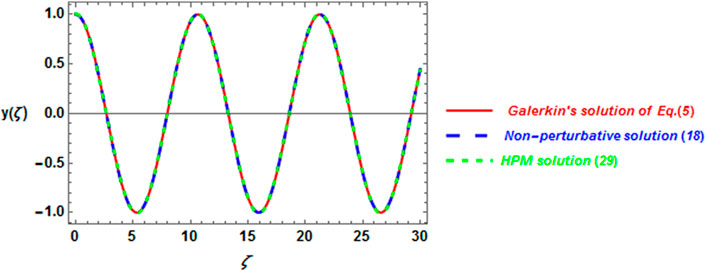
FIGURE 2. Comparison between the analytical periodic solutions by the non-perturbative and homotopy perturbation approaches (18) and (29), respectively, with Galerkin’s solution (Eq. 32).
The approximate solution, as given in Eq. 32, is sketched versus the parameter
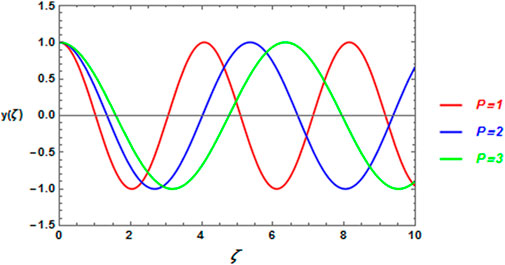
FIGURE 3. Influence of the parameter P on the periodic solution Eq. 32.
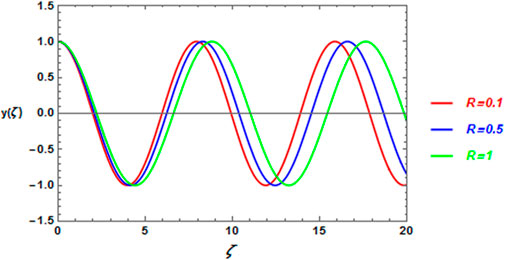
FIGURE 4. Influence of the parameter R on the periodic solution Eq. 32.
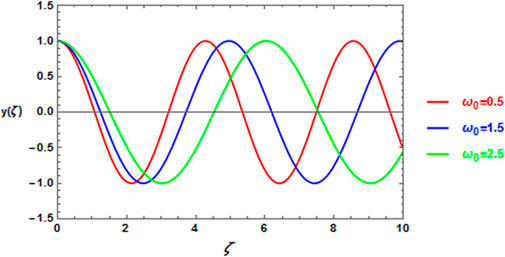
FIGURE 5. Influence of the parameter
The calculations are performed under the stability conditions that are given in Eq. 30. The stable distribution is located in the plane
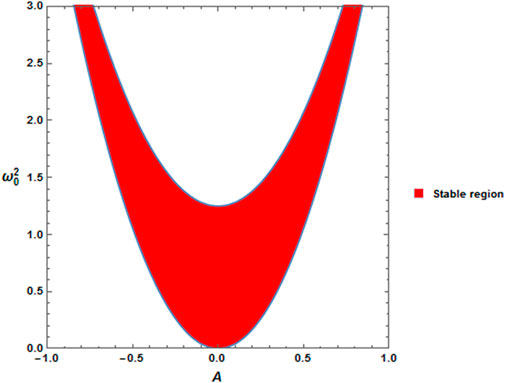
FIGURE 7. Stability distribution of the same system, as given in Figure 6, except that
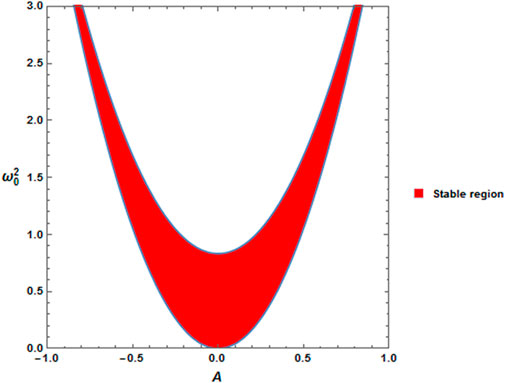
FIGURE 8. Stability distribution of the same system, as given in Figure 6, except that
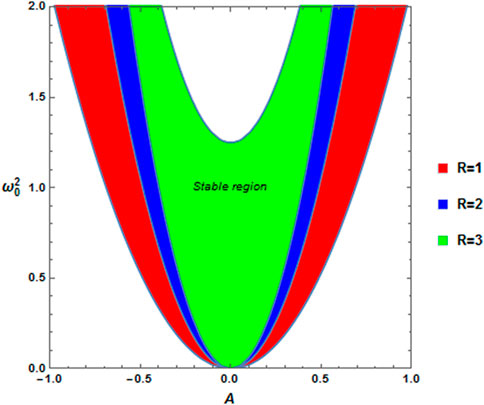
FIGURE 9. Stability distribution of the same system, as given in Figure 7, of
6 Conclusion
Away from the regular investigation of the nonlinear oscillators, the present article has been explained. This article deals with the nonlinear Duffing equation and obtains a new result of the periodic solution of a damped nonlinear Duffing oscillator and the damped Klein–Gordon equation by using a new technique named the rank upgrading technique. This technique first increases the order of the partial differential equation by differentiating the original differential equation. The alternative equation is obtained. The comparison between this alternative equation and the original equation shows that the obtained equation is corrected and can be used to perform the periodic solution. Its solution has been validated by applying the HPM to the alternative equation, in which the oscillation frequency obtained by the non-perturbative approach has been identical to that frequency obtained by the HPM. This frequency has been used to discuss stability behavior. A comparison of the periodic solutions’ curves was obtained using three different methods. Non-perturbative, modified homotopy perturbation, and Galerkin solutions showed an excellent agreement. This comparison also shows that the non-perturbative solution is closer to Galerkin’s solution than the HPM solution. Furthermore, this scheme is a new technique. Therefore, the present numerical method can be used for analyzing different acoustic waves and oscillations in plasma and different physical systems.
Data availability statement
The original contributions presented in the study are included in the article/Supplementary Materials, further inquiries can be directed to the corresponding author.
Author contributions
YE: conceptualization (equal), formal analysis (equal), investigation (equal), and methodology (equal). NE: conceptualization (equal), formal analysis (equal), investigation (equal), and methodology (equal). HA: conceptualization (equal), formal analysis (equal), investigation (equal), and methodology (equal).
Acknowledgments
The authors express their gratitude to Princess Nourah bint Abdulrahman University Researchers Supporting Project number (PNURSP2023R17), Princess Nourah bint Abdulrahman University, Riyadh, Saudi Arabia.
Conflict of interest
The authors declare that the research was conducted in the absence of any commercial or financial relationships that could be construed as a potential conflict of interest.
Publisher’s note
All claims expressed in this article are solely those of the authors and do not necessarily represent those of their affiliated organizations, or those of the publisher, the editors, and the reviewers. Any product that may be evaluated in this article, or claim that may be made by its manufacturer, is not guaranteed or endorsed by the publisher.
References
1. Alciatore DG. Introduction to mechatronics and measurement. 3rd ed New York: McGraw-Hill (2007). ISBN 978-0-07-296305-2.
2. Duffing G. Erzwunge Schweingungen bei Veränderlicher Eigenfrequenz. Braunschweig): F. Viewig u. Sohn (1918).
3. Yamanaka Y, Yamaoka N. Oscillation and non-oscillation theorems for Meissner's equation. Appl Math Comput (2021) 388:125526. doi:10.1016/j.amc.2020.125526
6. He JH. Homotopy perturbation technique. Comput Methods Appl Mech Eng (1999) 178:257–62. doi:10.1016/s0045-7825(99)00018-3
7. He JH, El-Dib YO. Homotopy perturbation method with three expansions. J Math Chem (2021) 59:1139–50. doi:10.1007/s10910-021-01237-3
8. He JH. New interpretation of homotopy perturbation method. Int J Mod Phys B (2006) 20(18):2561–8. doi:10.1142/s0217979206034819
9. Liu ZJ, Adamu MY, Suleiman E, He JH. Hybridization of homotopy perturbation method and Laplace transformation for the partial differential equations. Therm Sci (2017) 21(4):1843–6. doi:10.2298/tsci160715078l
10. Filobello-Nino U, Vazquez-Leal H, Herrera-May AL, Ambrosio-Lazaro RC, Jimenez-Fernandez VM, Sandoval-Hernandez M, et al. The study of heat transfer phenomena by using modified homotopy perturbation method coupled by Laplace transform. Therm Sci (2020) 24(2B):1105–15. doi:10.2298/tsci180108204f
11. He JH, El-Dib YO. Homotopy perturbation method for Fangzhu oscillator. J Math Chem (2020) 58(10):2245–53. doi:10.1007/s10910-020-01167-6
12. El-Dib YO. Stability approach for periodic delay Mathieu equation by the He-multiple-scales method. Alexandria Eng J (2018) 57:4009–20. doi:10.1016/j.aej.2018.01.021
13. El-Dib YO. Modified multiple scale technique for the stability of the fractional delayed nonlinear oscillator. Pramana - J Phys (2020) 94:56. doi:10.1007/s12043-020-1930-0
14. El-Dib YO. Multiple scales homotopy perturbation method for Non-Linear Oscillators. Nonlinear Sci Lett A (2017) 8(4):352–64.
15. El-Dib YO. Periodic solution of the cubic nonlinear Klein–Gordon equation, and the stability criteria via the He-multiple-scales method. Pramana - J Phys (2019) 92:7. doi:10.1007/s12043-018-1673-3
16. Adamu MY, Ogenyi P. Parameterized homotopy perturbation method. Nonlinear Science Letters A (2017) 8(2):240–3.
17. Vazquez-Leal H. Non-linearities distribution homotopy perturbation method to find solution for Troesch problem. Nonlinear Science Letters A (2018) 9(3):279–91.
18. Akgül A, Ahmad H. Reproducing kernel method for Fangzhu's oscillator for water collection from air. Math Methods Appl Sci (2020). doi:10.1002/mma.6853
19. Liu C, Kuo C, Chang J. Solving the optimal control problems of nonlinear Duffing oscillators by using an iterative shape functions method. Comp Model Eng Sci (2020) 122(1):33–48. doi:10.32604/cmes.2020.08490
20. Liu X, Chen X, Kang R, Shen X, Ni B. A coupled cavitation model in an oscillatory oil squeeze film. Comp Model Eng Sci (2020) 123(1):129–52. doi:10.32604/cmes.2020.07836
21. Shen Y, El-Dib YO. A periodic solution of the fractional sine-Gordon equation arising in architectural engineering. J Low Frequency Noise, Vibration Active Control (2021) 40(2):683–91. doi:10.1177/1461348420917565
22. El-Dib YO, Elgazery NS, Mady AA, Alyousef HA. On the modeling of a parametric cubic-quintic non-conservative Duffing oscillator via the modified homotopy perturbation method. Z für Naturforschung A (2022) 77(5):475–86. doi:10.1515/zna-2021-0354
23. El-Dib YO, Elgazery NS. Damped Mathieu equation with a modulation property of the homotopy perturbation method. J Sound Vibration (2022) 56:21–36. doi:10.32604/sv.2022.014166
24. Elgazery NS. A periodic solution of the newell-whitehead-segel (NWS) wave equation via fractional calculus. J Appl Comput Mech (2020) 6(SI):1293–300.
25. He JH, Yang Q, He CH, Khan Y. A simple frequency formulation for the tangent oscillator. Axioms (2021) 10:320. doi:10.3390/axioms10040320
26. Shokhanda R, Goswami P, He JH, Althobaiti A. An approximate solution of the time-fractional two-mode coupled Burgers equation. Fractal and Fractional (2021) 5:196. doi:10.3390/fractalfract5040196
27. He JH, Anjum N, Skrzypacz P. A variational principle for a nonlinear oscillator arising in the microelectromechanical system. J Appl Comput Mech (2021) 7(1):78–83.
28. He JH, El-Dib YO. The reducing rank method to solve third-order Duffing equation with the homotopy perturbation. Numer Methods Partial Differential Equations (2021) 37(2):1800–8. doi:10.1002/num.22609
29. Luo Z, Jin S. A reduced-order extrapolated Crank–Nicolson collocation spectral method based on proper orthogonal decomposition for the two-dimensional viscoelastic wave equations. Numer Methods Partial Differential Equations (2020) 36:49–65. doi:10.1002/num.22397
30. El-Dib YO. The damping Helmholtz–Rayleigh–Duffing oscillator with the non-perturbative approach. Mathematics Comput Simulation (2022) 194:552–62. doi:10.1016/j.matcom.2021.12.014
31. He JH, El-Dib YO. The enhanced homotopy perturbation method for axial vibration of strings. Fact universitatis, Ser Mech Eng (2021) 19:735. doi:10.22190/FUME210125033H
32. Jena RM, Chakraverty S, Jena SK. Dynamic response analysis of fractionally damped beams subjected to external loads using homotopy analysis method. J Appl Comput Mech (2019) 5(2):355–66. doi:10.22055/jacm.2019.27592.1419
33. Atabak R, Sedighi HM, Reza A, Mirshekari E. Analytical investigation of air squeeze film damping for biaxial micro-scanner using eigenfunction expansion method. Math Methods Appl Sci (2020). doi:10.1002/mma.6658
34. Yekrangisendi A, Yaghobi M, Riazian M, Koochi A. Scale-dependent dynamic behavior of nanowire-based sensor in accelerating field. J Appl Comput Mech (2019) 5(2):486–97. doi:10.22055/jacm.2018.27302.1393
35. Lin Y, Cui M. A new method to solve the damped nonlinear Klein-Gordon equation. Sci China Ser A: Math (2008) 51:304–13. doi:10.1007/s11425-008-0030-2
36. Pang Y, Yang Y. A note on finite time blowup for dissipative Klein–Gordon equation. Nonlinear Anal (2020) 195:111729. doi:10.1016/j.na.2019.111729
37. Parka JY, Jeong U. Optimal control of damped Klein–Gordon equations with state constraints. J Math Anal Appl (2007) 334:11–27. doi:10.1016/j.jmaa.2006.12.042
38. Côte R, Martel Y, Yuan X. Long-time asymptotics of the one-dimensional damped nonlinear Klein–Gordon equation. Archive Rational Mech Anal (2021) 239(3):1837–74. doi:10.1007/s00205-020-01605-4
39. Dehghan M, Ghesmati A. Application of the dual reciprocity boundary integral equation technique to solve the nonlinear Klein–Gordon equation. Comp Phys Commun (2010) 181(8):1410–8. doi:10.1016/j.cpc.2010.04.008
40. El-Dib YO, Elgazery NS. Effect of fractional derivative properties on the periodic solution of the nonlinear oscillations. Fractals (2020) 28(4):2050095. doi:10.1142/S0218348X20500954
41. El-Dib YO. Stability approach of a fractional-delayed duffing oscillator. Discontinuity, Nonlinearity, and Complexity (2020) 9(3):367–76.
42. El-Dib YO. Homotopy perturbation method with rank upgrading technique for the superior nonlinear oscillation. Math Comput Simulation (2021) 182:555–65. doi:10.1016/j.matcom.2020.11.019
43. El-Dib YO, Matoog RT. The rank upgrading technique for a harmonic restoring force of nonlinear oscillators. J Appl Comput Mech (2021) 7(2):782–9.
44. El-Dib YO. Immediate solution for fractional nonlinear oscillators using the equivalent linearized method. J Low Frequency Noise Vibration Active Control (2022) 41(4):1411–25. doi:10.1177/14613484221098788
45. El-Dib YO. Insightful and comprehensive formularization of frequency amplitude formula for strong or singular nonlinear oscillators. J Low Frequency Noise, Vibration Active Control (2023) 146134842211181. doi:10.1177/14613484221118177
46. El-Dib YO, Elgazery NS, Gad NS. A novel technique to obtain a time-delayed vibration control analytical solution with simulation of He’s formula. J Low Frequency Noise (2023). Vibration & Active Control. doi:10.1177/14613484221149518
47. He JH, El-Dib YO, Mady AA. Homotopy perturbation method for the fractal toda oscillator. Fractal and Fractional (2021) 5:93. doi:10.3390/fractalfract5030093
48. El-Dib YO. Criteria of vibration control in delayed third-order critically damped Duffing oscillation. Archive of Applied Mechanics (2021) 92(1):1–19. doi:10.1007/s00419-021-02039-4
Keywords: damping nonlinear oscillator, non-perturbative technique, modified homotopy perturbation method, stability analysis, rank upgrade technique
Citation: El-Dib YO, Elgazery NS and Alyousef HA (2023) A heuristic approach to the prediction of a periodic solution for a damping nonlinear oscillator with the non-perturbative technique. Front. Phys. 11:1122592. doi: 10.3389/fphy.2023.1122592
Received: 13 December 2022; Accepted: 20 January 2023;
Published: 10 February 2023.
Edited by:
Samir A. El-Tantawy, Port Said University, EgyptReviewed by:
Alvaro Salas, National University of Colombia, ColombiaAbdelhalim Ebaid, University of Tabuk, Saudi Arabia
Copyright © 2023 El-Dib, Elgazery and Alyousef. This is an open-access article distributed under the terms of the Creative Commons Attribution License (CC BY). The use, distribution or reproduction in other forums is permitted, provided the original author(s) and the copyright owner(s) are credited and that the original publication in this journal is cited, in accordance with accepted academic practice. No use, distribution or reproduction is permitted which does not comply with these terms.
*Correspondence: Yusry O. El-Dib, eXVzcnllbGRpYjUyQGhvdG1haWwuY29t
 Yusry O. El-Dib
Yusry O. El-Dib Nasser S. Elgazery
Nasser S. Elgazery Haifa A. Alyousef2
Haifa A. Alyousef2